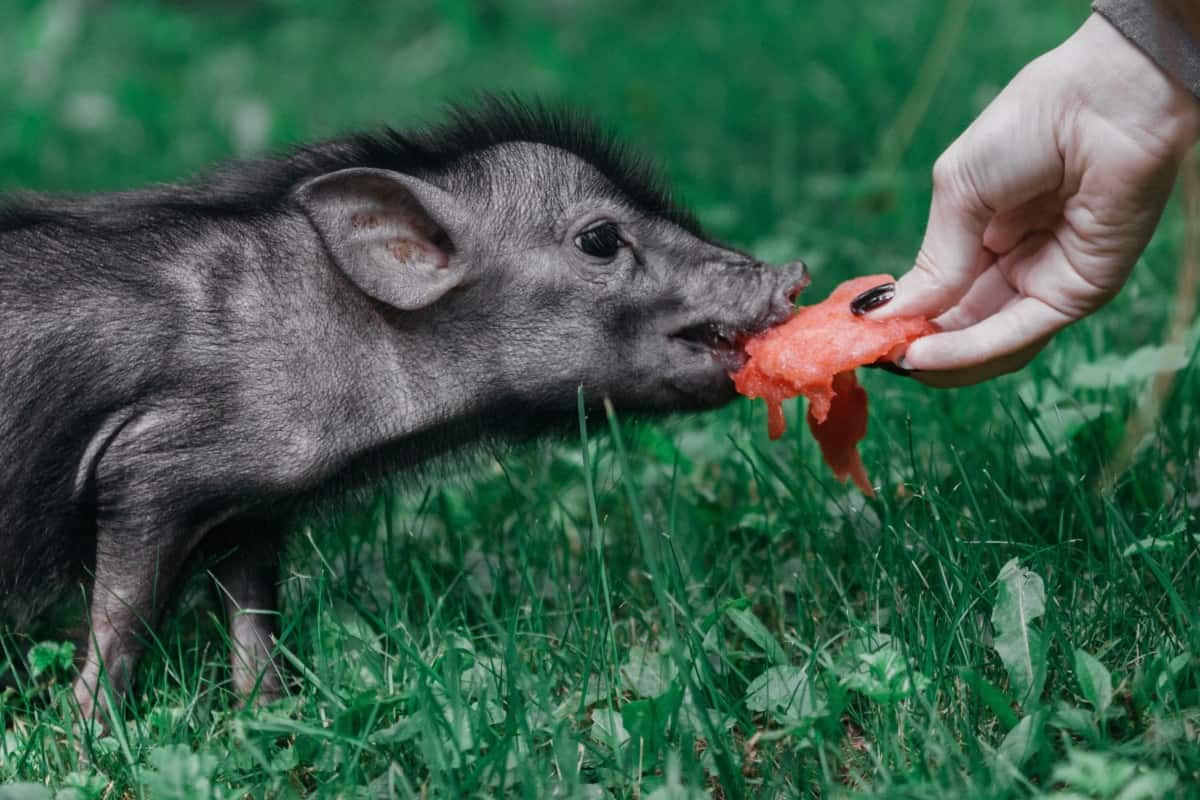In the oral cavity of pigs, unlike ruminants like sheep or cattle, the feed undergoes significant primary mechanical processing. The duration of chewing depends on the consistency and dryness of the feed.
The salivary glands in pigs are secreted periodically, i.e., saliva is secreted only during feeding. Perhaps conditioned reflex at the sight and smell of feed. The most powerful causative agent of the salivary glands is mechanical irritation of the receptors of the oral cavity.
Saliva of different quality and quantity is separated into different types of feed. Most saliva is separated into dry food, little saliva is separated into liquid feeds, so it is recommended to cook steep porridge for pigs.
About 10-15 liters of saliva are released per day, while the parotid glands account for more than half of the volume and maltase. Saliva contains amylolytic enzymes: amylase. Especially a lot of amylase is found in saliva when fed with oats and potatoes.
Digestion in the Stomach
The stomach in pigs is single-chamber, with a capacity of 6.5–9 l, unlike carnivores, it has an enlarged cardiac part, which occupies about half of the total stomach area. In the esophagus, the cardiac part of the stomach forms a blind sac – a diverticulum.
The glandular epithelium of the cardiac part produces alkaline mucus. Pepsin and hydrochloric acid are not. The esophagus zone adjacent to the esophagus is non-iron, covered with stratified epithelium.
The fundus accounts for approximately 35% of the total stomach area. The fundus gland zone produces acidic gastric juice (pH 0.7–2.0, and acidity 0.35–0.45%), which contains the enzymes pepsin, chymosin and lipase. About 20% of the total area falls on the pyloric part. Here, lipid is digested by lipase, including that which is discharged from the duodenum.
The food masses in the pig’s stomach mix slightly and are placed in layers as the feed arrives. Along with the physical properties, quantity and quality of feed received, a certain role in the separation of the contents of the stomach is played by pressure in the abdominal cavity, depending on the movements of the animal.
Anxiety and too vigorous movement, for example, with excessive density in the organs, can impede the process of separation of the contents of the stomach.
Intensive digestion of carbohydrates by saliva enzymes and plant feed enzymes takes place in the cardiac and blind sac zones. Here, under the influence of symbiotic microflora, carbohydrates are fermented, mainly due to lactic acid fermentation, but very little is formed of lactic acid (approximately 0.1%). When using silage feed, fermentation processes are suppressed.
The set of processes associated with the digestion of carbohydrates is referred to as the amylolysis phase. In the lower layers of the fodder mass, protein digestion processes predominate – the proteolysis phase. In the initial period of feed processing, mainly amylolysis processes occur, but with the spread of gastric juice, proteolysis processes begin to prevail.
However, it is impossible to clearly distinguish between these processes in space and time. Gastric juice is separated continuously, but the intake of food dramatically enhances secretion – the reflex phase.
The quantitative and qualitative composition of gastric juice depends on the type of food and animal appetite. Silo feed, bread, steep cereals, technologically processed food – ground and toasted grain enhance gastric secretion. After about 4-6 hours, about half of the food is evacuated from the stomach, the remains of the feed can be up to 16 or more hours.
Pregnancy and Digestion
There are several works performed on pregnant sows. In pregnant sows, by the end of pregnancy, the amount of digestive juice increases 2-fold with an increase in protein-digesting juice activity.
With the onset of lactation, the secretory activity of the gastric glands increases by almost 3 times compared with the initial value observed at the beginning of the pregnant period. The sow’s body experiences great functional stress during lactation, especially in highly productive animals.
It seems appropriate to know the dynamics of changes in the content of plastic and energy substances in highly productive sows in the body in connection with the intensity of their operation. A characteristic pattern has been established – with an increase in the number of farrowing, the level of plastic and energy supply of the body decreases significantly. In conditions of intensive use of highly productive sows with age, especially during lactation, there is a deficit in the content of energy-plastic substances, which begins to appear already in the period of the third lactation.
In the blood, a decrease in the content of:
- Total protein by 5.1,
- Total lipids – 4.6,
- Cholesterol – 12.5,
- Glucose – 8.7,
- ATP – 8.8,
- Inorganic phosphorus – 9.7,
- Organic phosphorus – 7.1 ,
- Magnesium – 20.3,
- Iron – 13.3% of the value of similar indicators in the first lactation.
With an increase in the number of farrowing, the deficit increased, and the decrease in the content of energy and plastic substances reached 35% of the level of the first lactation, taken as the initial level.
Digestion in the Intestines
In pigs, compared with other types of domestic animals, the small intestine is very long and has a relatively large capacity. In this regard, a significant part of the digestive processes proceeds in this segment.
It was found that in pigs, as in ruminants, the secretion of pancreatic juice is continuous. Juice secretion in them does not stop even with prolonged starvation. Unlike ruminants in pigs, there is close coordination of the motility of the stomach and intestines.
The neurohumoral mechanisms of regulation of the external secretion of the pancreas, the composition of pancreatic juice and its enzymatic profile in pigs are not fundamentally different from other animals. The pancreatic juice secretion is continuous, which is associated with the continuous secretion of gastric juice and its evacuation into the duodenum. Due to incomplete closure of the pyloric sphincter in pigs, the contents of the duodenum are thrown into the pyloric part of the stomach – regurgitation.
In the large intestine, mainly in the cecum, the most important biochemical processes occur – cellulose digestion and fermentation processes, but to a small extent, some enzymes of feed raw materials continue to act. Nitrogenous substances in the colon of pigs are used by microorganisms to build the proteins of their body and, since microorganisms are not digested in the colon, they are lost to the host animal.
As a result of the vital activity of microflora in the large intestine, a significant amount of vitamins accumulate, especially group B, but the possibility and degree of their use by the host organism has not yet been established. Since most vitamins are concentrated in microbial cells, which, as noted, are not digested in the large intestine, their availability is apparently limited.
The transit time of the feed through the digestive tract depends on many factors and ranges from several hours to several days. The unpleasant smell of feces is mainly due to skatole – this is the product of bacterial decay.
Conclusion
We talked about different species of pigs in our previous article and as you already know most pigs require special meal course, because most of their digestive system are different.
Mainly pigs have a lot of common, for example a lot of amylase is found in saliva when fed with oats and potatoes.Also some pigs’ diet requires exercises, long walks and special diets that farmers should always consider. First of all you should always research what kind of diet is best for the type of pig you have. Remember, your pigs’ productivity directly depends on the feed, so that’s why it is important to consider special diets.
As for the majority, some rules are mostly same for every piece: since a lot depends on the ferments in pigs’ digestive system, saliva helps a lot in this situation. You should always give them water and food that is not too dry, even though they still have enough saliva to handle it.
Pregnant sows are under high stress during pregnancy and lactation, so be sure to be more attentive of what you feed them during this time. The main point of helping pigs’ digestive system is to assign individual diet plans for different spices and you will get the maximum benefit from them.

